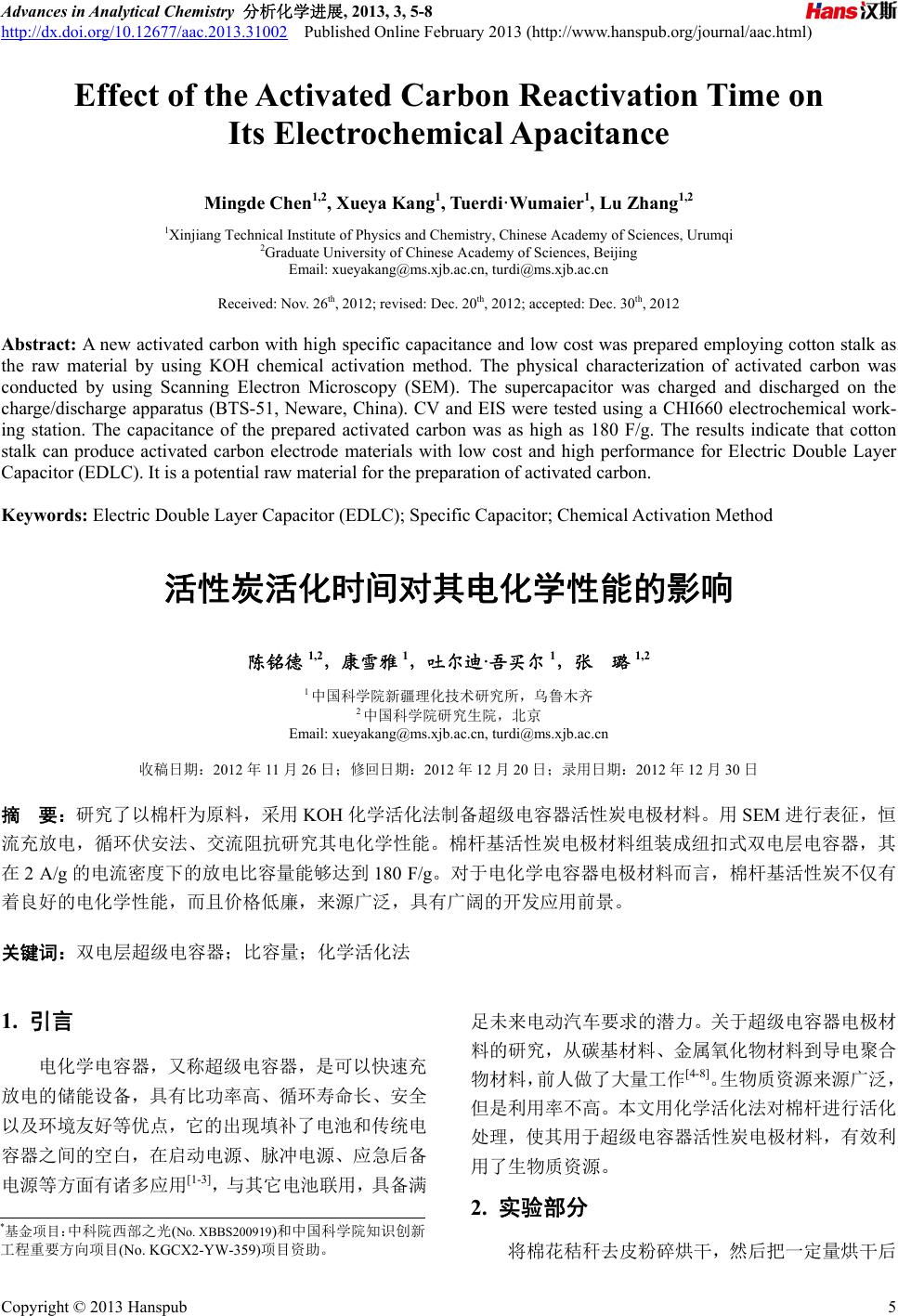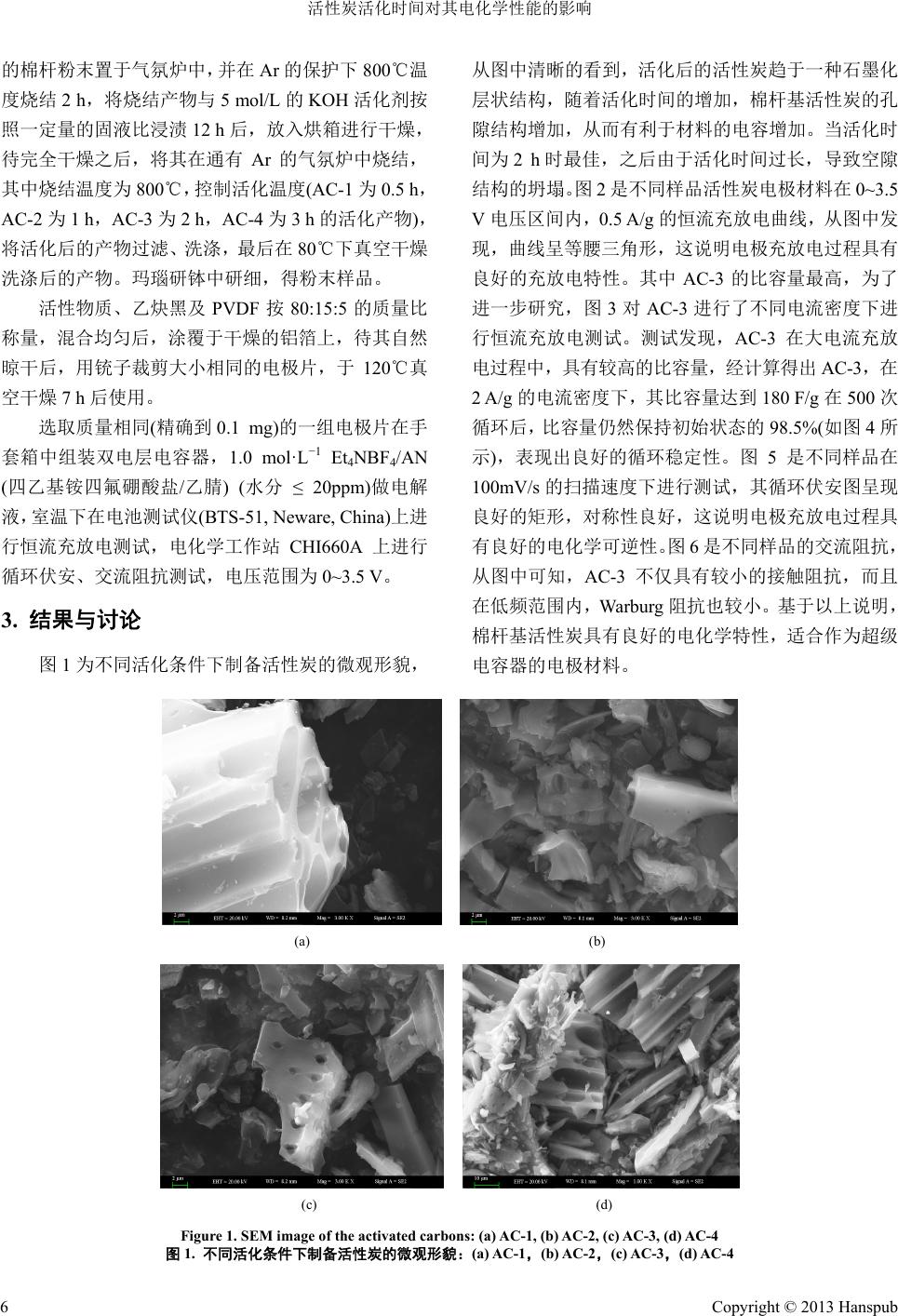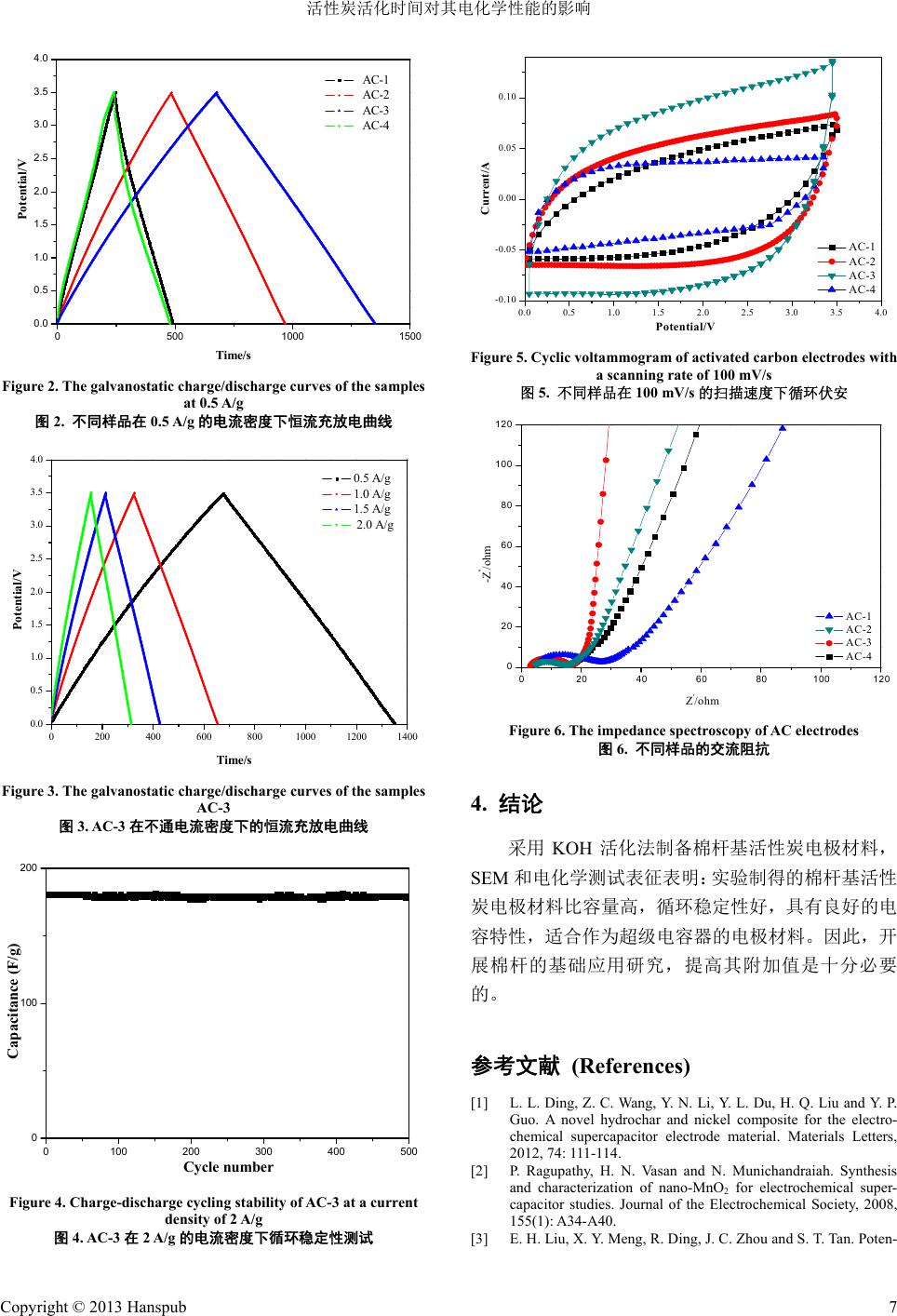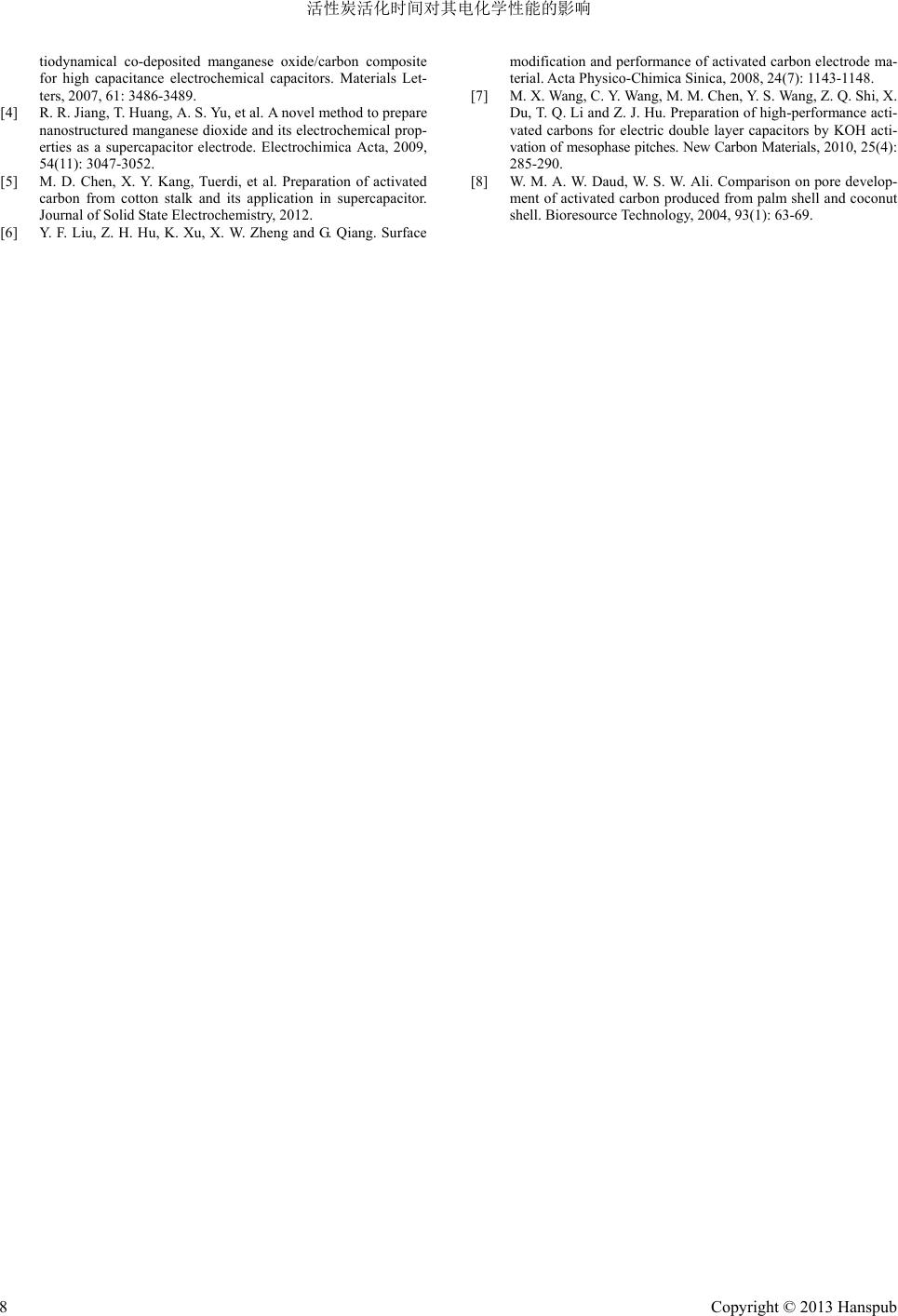 Advances in Analytical Chemistry 分析化学进展, 2013, 3, 5-8 http://dx.doi.org/10.12677/aac.2013.31002 Published Online February 2013 (http://www.hanspub.org/journal/aac.html) Effect of the Activated Carbon Reactivation Time on Its Electrochemical Apacitance Mingde Chen1,2, Xueya Kang1, Tuerdi·W u maier1, Lu Zhang1,2 1Xinjiang Technical Institute of Physics and Chemistry, Chinese Academy of Sciences, Urumqi 2Graduate University of Chinese Academy of Sciences, Beijing Email: xueyakang@ms.xjb.ac.cn, turdi@ms.xjb.ac.cn Received: Nov. 26th, 2012; revised: Dec. 20th, 2012; accepted: Dec. 30th, 2012 Abstract: A new activated carbon with high specific capacitance and low cost was prepared employing cotton stalk as the raw material by using KOH chemical activation method. The physical characterization of activated carbon was conducted by using Scanning Electron Microscopy (SEM). The supercapacitor was charged and discharged on the charge/discharge apparatus (BTS-51, Neware, China). CV and EIS were tested using a CHI660 electrochemical work- ing station. The capacitance of the prepared activated carbon was as high as 180 F/g. The results indicate that cotton stalk can produce activated carbon electrode materials with low cost and high performance for Electric Double Layer Capacitor (EDLC). It is a potential raw material for the preparation of activated carbon. Keywords: Electric Double Layer Capacitor (EDLC); Specific Capacitor; Chemical Activation Method 活性炭活化时间对其电化学性能的影响 陈铭德 1,2,康雪雅 1,吐尔迪·吾买尔1,张 璐1,2 1中国科学院新疆理化技术研究所,乌鲁木齐 2中国科学院研究生院,北京 Email: xueyakang@ms.xjb.ac.cn, turdi@ms.xjb.ac.cn 收稿日期:2012 年11 月26 日;修回日期:2012 年12 月20 日;录用日期:2012 年12 月30日 摘 要:研究了以棉杆为原料,采用 KOH 化学活化法制备超级电容器活性炭电极材料。用 SEM 进行表征,恒 流充放电,循环伏安法、交流阻抗研究其电化学性能。棉杆基活性炭电极材料组装成纽扣式双电层电容器,其 在2 A/g的电流密度下的放电比容量能够达到 180 F/g。对于电化学电容器电极材料而言,棉杆基活性炭不仅有 着良好的电化学性能,而且价格低廉,来源广泛,具有广阔的开发应用前景。 关键词:双电层超级电容器;比容量;化学活化法 1. 引言 电化学电容器,又称超级电容器,是可以快速充 放电的储能设备,具有比功率高、循环寿命长、安全 以及环境友好等优点,它的出现填补了电池和传统电 容器之间的空白,在启动电源、脉冲电源、应急后备 电源等方面有诸多应用[1-3],与其它电池联用,具备满 足未来电动汽车要求的潜力。关于超级电容器电极材 料的研究,从碳基材料、金属氧化物材料到导电聚合 物材料,前人做了大量工作[4-8]。生物质资源来源广泛, 但是利用率不高。本文用化学活化法对棉杆进行活化 处理,使其用于超级电容器活性炭电极材料,有效利 用了生物质资源。 2. 实验部分 *基金项目:中科院西部之光(No. XBBS200919)和中国科学院知识创新 工程重要方向项目(No. KGCX2-YW-359)项目资助。 将棉花秸秆去皮粉碎烘干,然后把一定量烘干后 Copyright © 2013 Hanspub 5  活性炭活化时间对其电化学性能的影响 的棉杆粉末置于气氛炉中,并在Ar的保护下 800℃温 度烧结 2 h,将烧结产物与 5 mol/L 的KOH 活化剂按 照一定量的固液比浸渍12 h 后,放入烘箱进行干燥, 待完全干燥之后,将其在通有 Ar的气氛炉中烧结, 其中烧结温度为800℃,控制活化温度(AC-1 为0.5 h, AC-2 为1 h,AC-3 为2 h,AC-4 为3 h的活化产物), 将活化后的产物过滤、洗涤,最后在80℃下真空干燥 洗涤后的产物。玛瑙研钵中研细,得粉末样品。 活性物质、乙炔黑及 PVDF按80:15:5 的质量比 称量,混合均匀后,涂覆于干燥的铝箔上,待其自然 晾干后,用铳子裁剪大小相同的电极片,于 120℃真 空干燥 7 h 后使用。 选取质量相同(精确到 0.1 mg)的一组电极片在手 套箱中组装双电层电容器,1.0 mol·L−1 Et4NBF4/AN (四乙基铵四氟硼酸盐/乙腈) (水分 ≤ 20ppm)做电解 液,室温下在电池测试仪(BTS-51, Neware, China)上进 行恒流充放电测试,电化学工作站CHI660A 上进行 循环伏安、交流阻抗测试,电压范围为 0~3.5 V。 3. 结果与讨论 图1为不同活化条件下制备活性炭的微观形貌, 从图中清晰的看到,活化后的活性炭趋于一种石墨化 层状结构,随着活化时间的增加,棉杆基活性炭的孔 隙结构增加,从而有利于材料的电容增加。当活化时 间为 2 h时最佳,之后由于活化时间过长,导致空隙 结构的坍塌。图 2是不同样品活性炭电极材料在 0~3.5 V电压区间内,0.5 A/g的恒流充放电曲线,从图中发 现,曲线呈等腰三角形,这说明电极充放电过程具有 良好的充放电特性。其中 AC-3 的比容量最高,为了 进一步研究,图 3对AC-3 进行了不同电流密度下进 行恒流充放电测试。测试发现 ,AC-3 在大电流充放 电过程中,具有较高的比容量,经计算得出 AC-3,在 2 A/g的电流密度下,其比容量达到 180 F/g 在500 次 循环后,比容量仍然保持初始状态的98.5%(如图 4所 示),表现出良好的循环稳定性。图 5是不同样品在 100mV/s 的扫描速度下进行测试,其循环伏安图呈现 良好的矩形,对称性良好,这说明电极充放电过程具 有良好的电化学可逆性。图 6是不同样品的交流阻抗, 从图中可知,AC-3 不仅具有较小的接触阻抗,而 且 在低频范围内,Warburg 阻抗也较小。基于以上说明, 棉杆基活性炭具有良好的电化学特性,适合作为超级 电容器的电极材料。 (a) (b) (c) (d) Figure 1. SEM image of the activated carbons: (a) AC-1, (b) AC-2, (c) AC-3, (d) AC-4 图1. 不同活化条件下制备活性炭的微观形貌:(a) AC-1,(b) AC-2,(c) AC-3,(d) AC-4 Copyright © 2013 Hanspub 6  活性炭活化时间对其电化学性能的影响 05001000 1500 0.0 0.5 1.0 1.5 2.0 2.5 3.0 3.5 4.0 Potential/V Time/s AC-1 AC-2 AC-3 AC-4 Figure 2. The galvanostatic charge/discharge curves of the samples at 0.5 A/g 图2. 不同样品在 0.5 A/g的电流密度下恒流充放电曲线 02004006008001000 1200 1400 0.0 0.5 1.0 1.5 2.0 2.5 3.0 3.5 4.0 0.5 A/g 1.0 A/g 1.5 A/g 2.0 A/g Potential/V Time/s Figure 3. The galvanostatic charge/discharge curves of the sample s AC-3 图3. AC-3在不通电流密度下的恒流充放电曲线 0100 200 300 400 500 0 100 200 Capacitance (F/g) Cycle number Figure 4. Charg e -discharge cycling stability of AC-3 at a current .0 density of 2 A/g 图4. AC-3在2 A/g的电流密度下循环稳定性测试 0.00.51.01.52.02.53.03.54 -0.10 -0.05 0.00 0.05 0.10 Current/A Pote n tial/V AC-1 AC-2 AC-3 AC-4 Figure 5 . Cyclic voltammogram of activated carbon electrodes wit a scanning rate of 100 mV /s h 图5. 不同样品在 100 mV/s的扫描速度下循环伏安 020 40 60 80100120 0 20 40 60 80 100 120 -Z''/ohm Z'/ohm AC-1 AC-2 AC-3 AC-4 Figure 6. The impedance spectroscopy of AC electrodes 图6. 不同样品的交流阻抗 4. 结论 KOH 活化法制备棉杆基活性炭电极材料, SEM 和电化学测试表征表明:实验制得的棉杆基活性 料 参考文献 (References) i, Y. L. Du, H. Q. Liu and Y. P. ckel composite for the electro- 采用 炭电极材 比容量高,循环稳定性好,具有良好的电 容特性,适合作为超级电容器的电极材料。因此,开 展棉杆的基础应用研究,提高其附加值是十分必要 的。 [1] L. L. Ding, Z. C. Wang, Y. N. L Guo. A novel hydrochar and ni chemical supercapacitor electrode material. Materials Letters, 2012, 74: 111-114. [2] P. Ragupathy, H. N. Vasan and N. Munichandraiah. Synthesis and characterization of nano-MnO2 for electrochemical super- capacitor studies. Journal of the Electrochemical Society, 2008, 155(1): A34-A40. [3] E. H. Liu, X. Y. Meng, R. Ding, J. C. Zhou and S. T. Tan. Poten- Copyright © 2013 Hanspub 7  活性炭活化时间对其电化学性能的影响 tiodynamical co-deposited manganese oxide/carbon com de and its electrochemical prop- stalk and its application in supercapacitor . W. Daud, W. S. W. Ali. Comparison on pore develop- posite modification and performance of activated carbon electrode ma- terial. Acta Physico-Chimica Sinica, 2008, 24(7): 1143-1148. [7] M. X. Wang, C. Y. Wang, M. M. Chen, Y. S. Wang, Z. Q. Shi, X for high capacitance electrochemical capacitors. Materials Let- ters, 2007, 61: 3486-3489. [4] R. R. Jiang, T. Huang, A. S. Yu, et al. A novel method to prepare nanostructured manganese dioxi erties as a supercapacitor electrode. Electrochimica Acta, 2009, 54(11): 3047-3052. [5] M. D. Chen, X. Y. Kang, Tuerdi, et al. Preparation of activated carbon from cotton . me Journal of Solid State Electrochemistry, 2012. [6] Y. F. Liu, Z. H. Hu, K. Xu, X. W. Zheng and G. Qiang. Surface Du, T. Q. Li and Z. J. Hu. Preparation of high-performance acti- vated carbons for electric double layer capacitors by KOH acti- vation of mesophase pitches. New Carbon Materials, 2010, 25(4): 285-290. [8] W. M. A. nt of activated carbon produced from palm shell and coconut shell. Bioresource Technology, 2004, 93(1): 63-69. Copyright © 2013 Hanspub 8 |